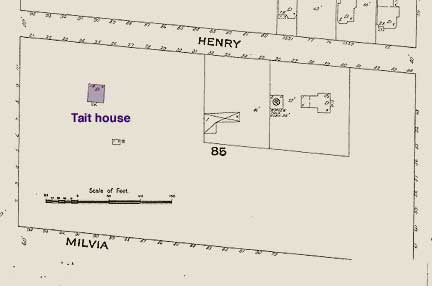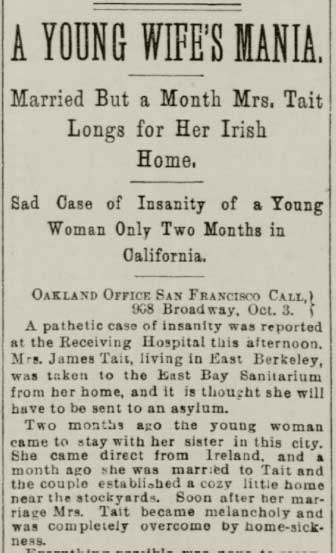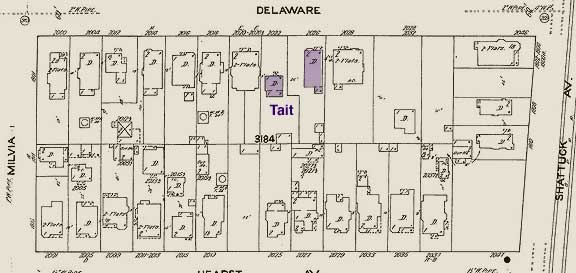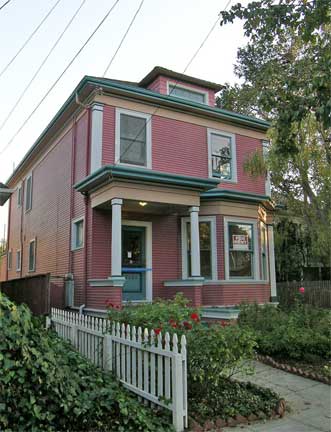Campus janitor beats professors in popularity race
28 September 2009
Broom in hand, Jimmy Tait wins “The Race for Popularity.” (1900 Blue and Gold)
In its 136 years, the University of California’s Berkeley campus has seen many buildings come and go. Among them, North Hall was the only one to have merited a demolition ceremony attended by the U.C. president and 700 alumni.
Like South Hall, which housed the library, museums, and laboratories, North Hall was designed in the Second Empire style by Scottish-born architect David Farquharson. But unlike the brick-and-stone South Hall, North Hall was built in wood to house classrooms, assembly room, and faculty rooms, with the basement devoted to student activities.
North Hall, one of the first two buildings on the U.C. campus (courtesy of Sarah Wikander)As early as 1902, North Hall was identified as a fire trap by Berkeley Fire Chief James Kenney, yet the building continued to be the center of student life until 1917, when it was ceremonially torn down, President Benjamin Ide Wheeler striking the first blow.
James Tait on the stairs of North Hall, 1899 (Bancroft Library, U.C. Berkeley)For eighteen of North Hall’s best years, its most enduring fixture was an Irishman by the name of James Tait, whom the students called “Jimmy Potatoes.”
James Tait (1865–1906) was the janitor of North Hall. He immigrated to the United States in 1888 and must have made his way directly to Berkeley, for the following year he was listed in the city directory as a laborer on the U.C. grounds.
It didn’t take long for Tait to become a student-body favorite. His obituary, published in the San Francisco Call on 20 February 1906, would attest to his geniality:
His keen Irish wit, unfailing good humor, genuine interests in the doings of the undergraduate host, and the faculty of making friends with those of high and low degree served to give “Jimmy Potatoes” distinction that mightier, richer men cannot acquire.
The Tait house in its first location on Henry Street south of Vine (Sanborn fire insurance map, 1894)A thrifty man, in 1894 Tait managed to buy land on the west side of Henry Street below Vine (currently 1508 Henry Street) and erected on it a very small house. Whether he lived in it or not is unclear, since the city directory sometimes indicated North Hall as his residence.
In the late summer of 1897, Tait married Bella White (1876–1963), newly arrived from Ireland. Acquiring a lot at 2022 Delaware Street, he moved his Henry Street house to the new location and enlarged it in a modest way.
The Tait house in its second location, 2022 Delaware Street, c. 1939 (Ormsby Donogh files, BAHA archives)Newspaper accounts of the period reported that Tait did everything to make his young bride comfortable in her new home. Unhappily, Bella was homesick, and within a few weeks of the marriage fell into melancholy so morbid that she couldn’t be safely left alone. In early October 1897 she was taken to the East Bay Sanitarium in Oakland. Upon her discharge three weeks later, her husband promised to send her back to Ireland and made arrangements for a married woman of their acquaintance to accompany her there. The night before the two women were to depart, Bella disappeared. She was found the next morning lying in a muddy pond, in a condition described as “hopelessly insane.”
San Francisco Call, 4 Oct. 1897The trip to Ireland was cancelled, and Mrs. Tait was hospitalized again. On 18 February 1898, the San Francisco Call announced:
Somehow, Bella Tait pulled through with no further incident. In April 1899 she gave birth to the couple’s daughter, Sadie. Their son, John, was born in June 1900. By then, Jimmy Tait had been twice enshrined in the university’s Blue and Gold yearbook. The 1900 edition (published in 1899) carried an unsigned four-stanza poem titled “Jimmy,” illustrated by a photograph of the janitor on the stairs of North Hall, feather duster in hand. The poem conveys the writer’s sentiment succinctly:The Californian-Occident baseball game will take place on the campus tomorrow morning at 11:15. The proceeds of the game will go to the benefit of James Tait, better known as “Jimmy,” the janitor of North Hall, who recently had the misfortune of having to send to the insane asylum his wife, who had come all the way from Ireland to wed him.
What is yon bright and stately being,
Which, with movement slow and calm,
Telleth o’er the moments fleeing
Ere he sound the loud alarm?
It is Jimmy.Now with pail and now with shovel,
Like an angel, bright is he,
As he cleans and sweeps this hovel,
Making it divine for me.
It is Jimmy.O the bright and happy creature,
Thou hast taught a lesson true,
How a man, in look and feature,
May become sublime, like you!
Like Jimmy.For what upon this earth is better
Than to help some fellow man,
Than ot make his hard life sweeter,
Helping him whene’r you can.
Thus does Jimmy.Elsewhere in the same yearbook, an irreverent two-page cartoon titled “The Race for Popularity” depicted eleven men staggering haphazardly through a footrace. Nine of them, identified by name and tagged “also ran,” were members of the faculty (a tenth was not identified). Ahead of all at the finish line, wearing patched trousers and carrying a broom and a smile, was the one person who needed no introduction: “Jimmy” Tait.
The “also ran” (in the order their names appear in the cartoon)
Archie B. Pierce Instructor in Mathematics Tommy F. Sanford Assistant Professor of English Literature Frank Soule Professor of Civil Engineering and Astronomy C.B. Bradley Professor of Rhetoric Freddy Slate Professor of Physics C.P. Nott Assistant in Botany Henry T. Ardley Associate Professor of Decorative and Industrial Arts Captain Emil Kellner Foreman of Central Agricultural Experiment Station Grounds William Carey Jones Professor of Jurisprudence “The cartoon was not appreciated by the authorities,” reported the San Francisco Call on 20 February 1906, continuing:
and, with other objectionable matter, was regarded as ground for the suspension of the editor and manager of the publication. “Jimmy Potatoes’” fame was largely increased by the affair, and he became more than ever an idol of the campus.
Indeed, Tait made an appearance in Joy Lichtenstein’s book For the Blue and Gold: A Tale of Life at the University of California (1901), where an account of the final exams produced this reminiscence:
Before they knew it they were all through, and the erstwhile echoing corridors of North Hall quieted down. For a while would “Jimmy Potatoes” cease from tolling the North Hall recitation bell.
The University Conservatory c. 1920 (Picturing Berkeley, a Postcard History)By 1902, James Tait had been reassigned from North Hall to gardening duties in the campus greenhouses and along its walks. The 1903 Blue and Gold lovingly marked his new role:
The Conservatory dates from the year of the Midwinter Fair. It is an appanage of the Agricultural and Botanical departments, and contains tropical or delicate plants, many being quite rare specimens, such as the celebrated Jimmy Potatoes, imported at great expense from Ireland.
When California Hall was completed in 1905, Tait became janitor of this modern edifice. There, in early February 1906, he was unpacking books when one of his hands received a scratch. He paid no attention to the cut until his arm began to swell. Alarmed, he consulted Dr. George Reinhardt, the university physician, and was sent to Providence Hospital in Oakland, where he died of septicemia two weeks later.
San Francisco Call, 20 Feb. 1906On the day of his death, 19 February 1906, the campus flag was lowered to half mast, and President Wheeler’s office released the following announcement:
James Tait, for many years a faithful servant of the University of California, long Janitor of North Hall, afterward employed on the university campus in various capacities, and more recently janitor of California Hall, died to-day in the Providence Hospital in Oakland. Mr. Tait was known to every student of the university for many years past for his unfailing kindliness of heart. His death will be sincerely mourned.
Gardening, 15 March 1906Almost immediately, Professor Albin Putzker, head of the university’s German Department, initiated a fundraising drive for the benefit of the widow. His call was taken up by the Daily Californian, which proposed to raise $1,000 in order to retire the $900 mortgage on the Tait home. On 10 March, the U.C. varsity baseball team played a benefit game against St. Mary’s College of Oakland. The University Cadet Band provided music, and President Wheeler pitched the first ball, attracting 600 spectators. A few days later, a benefit party was held at a skating rink. On 10 April, the band held a moonlight benefit concert of popular songs in the Greek Theatre. News of donations to the fund was published almost daily on page one of the Daily Cal. In mid-April, the newspaper announced that the fund had reached its goal.
The Daily Californian, 9 March 1906
The two Tait-Belford houses in 1911 (Sanborn fire insurance map)
And what of the bereaved family? They remained on Delaware Street for sixty more years. In 1908, Bella Tait married Stephen Belford (1870–1935), another Irish laborer who worked for a while as campus gardener. In 1909, the Belfords constructed a larger house next door at 2026 Delaware Street, on a lot acquired by James Tait in 1901.
The small Tait house, right, and the larger house built by Tait’s widow at 2026 Delaware Street, left, c. 1939 (Ormsby Donogh files, BAHA archives)The family held on to both houses, living in the older one until 1919 or so, then moving next door. In 1944, the twice-widowed Bella sold 2026 Delaware Street. She and her son John returned to the smaller house, where they lived into the 1960s. Bella died in 1963, John in 1966.
In 1967, Bella’s two married daughters, Sadie Tait Smyrl and Mary Belford Fyffe, sold the Tait house to Premium Partners, a realty company headed by Richard Bachenheimer. Premium had also acquired the former Belford house and turned them both into rental properties.
In 1909, Bella Tait and her second husband, Stephen Belford, built this Colonial Revival house at 2026 Delaware Street. (photo: Daniella Thompson, 2009)
The former Tait house at 2022 Delaware St. was lifted and a new floor built below. (photo: Daniella Thompson, 2008)
Among the notable residents of 2022 Delaware St. were David Wallechinsky and his sister, Amy Wallace. According to Planning Commissioner Patti Dacey, who lived at 2026 Delaware St. from 1973 to 1975, the little Tait house next door also served as home to members of the Hog Farm. Dacey recalls that 2022 Delaware St. was known as the “Rose Garden,” since the tenants planted its front yard in roses.
The tenants of both houses participated in the mass rent strike organized by the Berkeley Tenants Union in the early 1970s. When they were finally evicted, they took the roses with them.
A shorter version of this article was published in the Berkeley Daily Planet on 1 October 2009.
Copyright © 2009–2019 Daniella Thompson. All rights reserved.















